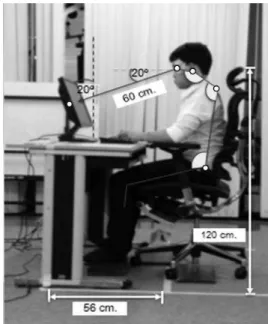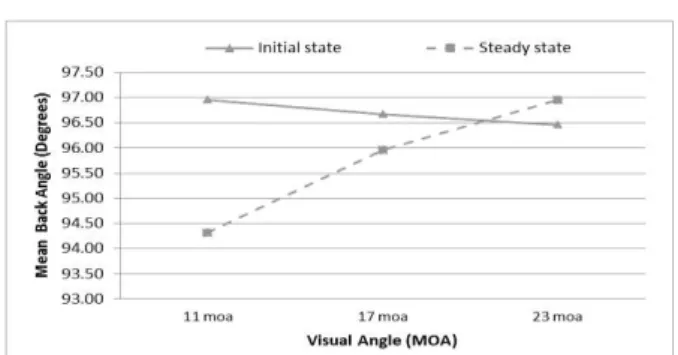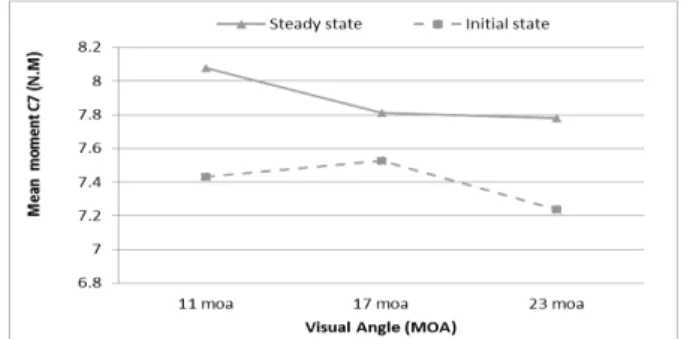Abstract—Non-ergonomic workstation is a cause of office syndrome especially the improper dimension of table and chair of computer workstation causes the neck, shoulder and lower back pain. Based on ISO9241, 1998, the recommended visual angle should be set at 16-24 minute of arc (MOA). The non-neutral sitting posture is not only caused by the workstation dimension but also the character size displayed on computer monitor. In order to keep the proper visual angle, the smaller character size causes the closer watching distance by leaning forward the upper body while using the computer. Leaning forward the upper body for long period may cause the upper body pain. There were 25 subjects from the university students joined in this study. Three character heights on the monitor were initially set at 11, 17 and 23 MOA in order to find the effects on the upper body posture. Subjects used computer by editing the random sets of English character for 5 minutes and then their neck and back angles were recorded in Sagittal plane by OptiTrack system with 12 cameras
The result showed that the character height significantly effects on the upper body posture due to back, neck and head angle changed from subject’s behavior that lean forward in order to get their desired visual angle at 23 MOA. Since, even slightly change in neck angle is moment at 7th cervical spine which may cause the shoulder and neck pains of the office syndrome. Therefore, the use of initial visual angle at 23-25 MOA is recommended to reduce risk from office syndrome.
Index Terms— visual angle, ergonomics, office syndrome
I. INTRODUCTION
Visual angle is the relationship between object’s height and its distance to the eyes. The recommended for font size for computer used is 16-24 MOA [1].
Today computer software is widely used around the world in many areas such as service, government and industry. Default character sizes for these software are 9 point, 10 point and 12 point [2] and 14 point for header as a standard [3] (font height is about 2.1 mm, 2.6 mm, 3.2 mm and 4 mm. respectively). Different character height affects to visual angle and lead to different working posture that crates tension at neck, shoulder and arm positions.
Prolong and awkward posture is the major factor of office syndrome; e.g. Myofascial Pain Syndrome (MPS), Regional muscle pain or contraction knot.
Manuscript received January 11, 2016.
Prattana Niramol. Author is with the Industrial Engineering Department, Faculty of Engineer, Chulalongkorn University, Bangkok, Thailand (e-mail: prattana.n@student.chula.ac.th)
Phairoat Ladavichitkul. Author is with the Industrial Engineering Department, Faculty of Engineer, Chulalongkorn University, Bangkok, Thailand (phone: +662-218-6814; fax: +662-218-6813; e-mail: phairoat.l@chula.ac.th)
This result from insufficient blood supply to muscle and less oxygen in muscle fiber and become permanent pain [4] especially at neck, shoulder and back [5]. There is also evidence that using computer more than 8 hours a day with prolonged static contraction is identified risk for neck and shoulder pain [6]. In addition, it also affects subject discomfort at lower body [7]-[10]. Likewise, Improper sitting posture over a long period of time causes a herniated disc [11] from the moment on the 7th cervical spine (C7) [12].
Testing was performed according to research from [13] Burgess-Limerick, Plooy and Ankrum by capturing the posture change of computer user with reference point of spines at L5/S1, C7, C1 and outer canthus. [13] Work station was set up following ergonomic recommendation. Serif-Arial font was selected for the testing since it has stable line and mostly used for display. Each test was performed in 5 minutes [14] via in-house software to simulate and collect typing task. During the testing, subject’s back, neck and head positions were recorded in 3D and analyzed in sagittal plane via 12 cameras of OptiTrack System.
In effects, the objective of this research is to study the effect of visual angle on upper body posture; back, neck and head angle. Visual angle was defined as independent variable, distance as controlled variable under ergonomic working condition and angle captured as the response. In addition, this study also explains moment created at C7 from different back, neck and head angles. The result will be used as the recommendation for visual angle in computer use or develop automatics font size program which reduces risk from office syndrome.
II. METHODOLOGY A. Subjects
Twenty-five participants were both male and female aged from 21 to 28 years (mean 24.5 years) with good health without hand or arm injury experiences. In case of any abnormal vision, subjects can use their eye glasses or contact lens.
B. Font type and sizes
Capital character with 9, 10, 12 and 14 point of San Serif- Arial font was used in the test. Character’s heights were calculated with the result as 2.1mm, 2.6 mm, 3.2 and 4 mm respectively (Table. 1)
A Preliminary Study of the Effect of Visual
Angle on Upper Body Posture of Computer
Users
Prattana Niramol, Phairoat Ladavichitkul
Proceedings of the International MultiConference of Engineers and Computer Scientists 2016 Vol II, IMECS 2016, March 16 - 18, 2016, Hong Kong
ISBN: 978-988-14047-6-3
ISSN: 2078-0958 (Print); ISSN: 2078-0966 (Online)
C. Visual Angle
Visual angle can be calculated from
V=
2
arc tan (S/2
D) …..(1) When V isvisual angle (MOA)S is object’s height
D isdistance between object to the eyes
According to the formula (1), when distance is initial set up as 60 cm, visual angle of object’s height as 2 mm, 3mm and 4mm are 11, 17 and 23 MOA respectively.
D. Body angles
Body angles and position is based from Burgess, Plooy and Ankrum’s research [13]. Five positions were identified as 1) Disc between the 5th Lumber and Sacral (L5/S1), 2) the 7th Cervical (C7), 3) the mastoid process on a line joining the tragus and the outer canthus (MP), 4) Outer canthus of the eye (OC) and 5) Center of monitor. Hence, angles were identified as response from Biomechanics Joint – Joint which are Back angle: Ө1; created by Line from L5/S1 to C7 and horizontal line, Neck Angle: Ө2; angle between C7 and mastoid process on a line joining the tragus and the outer canthus (MP) crossed with line from C7 and L5/S1, Head Angle: Ө3; created from line from the mastoid process on MP and outer canthus of the eye: OC crossed with line from C7 and MP [15].
Fig. 1. Three angles on upper body
E. Workstation
OptiTrack was set up for recording neck angle, neck angle and head angle in Sagittal plane, frame rate as 50 frames per second with 12 cameras. Temperature was controlled at 24°c
and lighting condition set up with 400 Lux. Workstation was set according to ergonomic standard with office table (Length: 130 cm, Width: 60 cm, Height: 75 cm), HP Monitor (LE1901W): 19 inches LCD (1280 x 1024 pixels) with viewing angle = 20°, and a standard keyboard.
Fig. 2. The In-house program
Fig. 3. Computer workstation setting for experiment. From Fig 3, the reflective balls were attached to 5 positions; 1st position is at lumbar segment 5 and sacral segment 1 (L5/S1), 2nd position set at Cervical segment 7 (C7), 3rd position set at the mastoid process on a line joining the tragus and the outer canthus (MP), 4th position set at the outer canthus of the eye (OC) and 5th position set at the center of monitor. All subjects sit at 120 cm. height from floor to fourth position (OC). Since each individual height is different, foot board was used for keep knee angle at 90°-120°. Distance from 4th and 5th positions was set up at 60 cm. and the viewing angle was set before all testing at 20°.
F. Method
Testing was set up with 3 conditions, 11 MOA, 17 MOA and 23 MOA. At the beginning, all subjects started with 23 MOA and 10 Capital Characters were randomly show at each time, once typing was finished another set of 10 characters would showed up until the testing time was reached at 5 minutes. After the first condition with 23 MOA completed, 17 MOA and 11 MOA were done with the same protocol. All subjects had 5 minutes rest between each condition.
G. Analysis
Neck pain is one of the major complaints for computer TABLEI
CHARACTERS PROPERTIES
Arial Characters Font
Characters Height
(mm.)
Height for Test (mm.)
A S D F G H
A S D F G H
A S D F G HA S D F G H
14
12
10
9
4
3.2
2.6
2.1
4
3
2
Proceedings of the International MultiConference of Engineers and Computer Scientists 2016 Vol II, IMECS 2016, March 16 - 18, 2016, Hong Kong
ISBN: 978-988-14047-6-3
ISSN: 2078-0958 (Print); ISSN: 2078-0966 (Online)
users. Therefore, this study analyzed a biomechanics at the neck to find the effect of visual angle on the neck moment. The angle data was kept in axis (X, Y) and all 5 positions at 3 conditions was used to calculate the neck moment as shown in free body diagram. Back angle, neck angle and head angle were collected from the initial state to the steady state in order to analyst the impact from visual angle with T-test analysis.
Fig. 4. Free body diagram for estimate of back angle, neck angle and head angle
Fig. 5. Moment atC7
From Fig.5, the moment at C
7
calculation based on static equilibrium as;
∑M = ME1-(W1 × L1CosӨx) = 0 …..(2)
Where W1 = Head and neck weight (Segment
weight/body weight x body weightx 9.8 m-s2)
L 1 =Length fromMPtoC7
Өx =Angle of C7 ME1 = Moment at C7
The experiment had been segment weight/body weight of head and neck equal to 0.081 [16].
III. RESULTS
Fig. 6. Mean Back angle at 3 Visual Angles
Mean Back angle at initial state from analysis with 3 conditions; 11 MOA, 17 MOA and 23 MOA are 96.96˚, 96.67˚, 96.45˚ and the mean Back angle after steady state are 94.32˚, 95.96˚, 96.96˚. From T-test analysis with standard deviation = 0.05, there was no impact for back angle change from 23 MOA and 17 MOA (P-VALUE = 0.65, 0.20 respectively) and 11MOA had impact to back angle change (P-VALUE = 0.00023)
(Fig.6)
Fig. 7. Mean Neck angle at 3 Visual Angles
Mean neck angle at initial state from analysis with 3 conditions; 11 MOA, 17 MOA and 23 MOA are 119.76˚, 120.14˚, 120.98˚ and the mean neck angle after steady state are 115.46˚, 116.76˚, 114.00˚. From T-test analysis with standard deviation = 0.05, there was no impact for neck angle change from 23 MOA (P-VALUE = 0.10) while 11 MOA and 17 MOA affect to neck angle change (P-VALUE = 0.011, 0.01 respectively)(Fig.7)
Fig. 8. Mean Head angle at 3 Visual Angles
Mean Head angle at initial state from 3 conditions; 11 MOA, 17 MOA and 23 MOA are 119.76˚, 120.14˚, 120.98˚ and the mean Head angle after steady state are 115.46˚,
Proceedings of the International MultiConference of Engineers and Computer Scientists 2016 Vol II, IMECS 2016, March 16 - 18, 2016, Hong Kong
ISBN: 978-988-14047-6-3
ISSN: 2078-0958 (Print); ISSN: 2078-0966 (Online)
116.76˚, 114.00˚. From T-test analysis with standard deviation = 0.05, we found no impact for Head angle change from 23 MOA (P-VALUE =0.37) while 11 MOA and 17 MOA affect to Head angle change (P-VALUE = 0.044, 0.00089) (Fig.8)
Fig. 9. Mean Moment on C7 at 3 Visual Angles
The mean moments at initial state from 3 conditions, 11 MOA, 17 MOA and 23 MOA were 205.56 N.M, 203.03 N.M. and 199.64 N.M., respectively and the mean moments on C7 at Steady state were and 221.5 N.M., 212.67 N.M. and 211.39 N.M., respectively. From T-test analysis with standard deviation = 0.05, it showed that all visual angles impact on the moment on C7 (P-VALUE = 0.0003, 0.01 and 0.005 respectively) (Fig.9)
IV. CONCLUSION AND DISCUSSION
From the result, the visual angle has a significant effect on the upper body posture especially at the 11 MOA and 17 MOA (equivalent to font size 9 point and 10 point in testing condition) causing subjects lean forward for their desire visual angle at 23 MOA. At the initial condition at 23 MOA (SD=1.08), there was no significant change on the upper body posture with the lowest moment joint on 7th cervical spine. Then the font size at 23 MOA should be recommended as the most appropriate visual angle for computer used in order to reduce risk from office syndrome.
REFERENCES
[1] ISO, 9241–11. “Ergonomic requirements for office work with visual display terminals (VDTs),” The international organization for standardization, 1998.
[2] M.L. Bernard, B.S. Chaparro, M.M. Mills and C.G. Halcomb, "Comparing the effects of text size and format on the readibility of computer-displayed Times New Roman and Arial text," International Journal of Human-Computer Studies, vol. 59, no. 6, pp. 823–835, Dec. 2003.
[3] D. Kingery and R. Furuta, “Skimming electronic newspaper headlines: A study of typeface, point size, screen resolution, and monitor size,”Information Processing & Management, vol. 33, no.5, pp.685–696, Sep. 1997.
[4] R. Fricton, R. Kroening, H. Dennis and S. Ralf, “Myofascial pain syndrome of the head and neck: a review of clinical characteristics of 164 patients,” Oral surgery, oral medicine, oral pathology, vol.60, no.6, pp. 615–623, 1985.
[5] J. Travell and S.H. Rinzler, “The myofascial genesis of pain,”
Postgrad. Med, 11, pp.425–43, 1952.
[6] J.B. Carter and E.W. Banister, “Musculoskeletal problems in VDT
work: a review,” Ergonomics, vol. 37, no. 10, pp.1623–1648, Oct. 1994.
[7] D.B. Chaffin, “Localized muscle fatigue-definition and
measurement”, Journal of Occupational and Environmental
Medicine, vol. 15, no. 4, pp.346–354, Apr. 1973.
[8] M. Hagberg, “Electromyographic signs of shoulder muscular fatigue
in two elevated arm positions,” American Journal of Physical
Medicine & Rehabilitation, vol. 60, no. 3, pp.111–121, Jun. 1981.
[9] R. Kadefors, I. Petersen and P. Herberts, “Muscular reaction to
welding work: an electromyographic investigation,”Ergonomics, vol.
19, no. 5, pp.543–558, Sep. 1976.
[10] E. Viikari-Juntura, “Occupational risk factors for shoulder disorders,”
Occupational Biomechanics Handbook, CRC Press, Boca Raton,
1999.
[11] Bumrungrad.com, “Herniated Disc - Back/ Leg pain,”Bumrungrad Hospital Bangkok, 2016. [Online]. Available: https://www.bumrungrad.com/en/spine-institute-surgery-bangkok-thailand-best-jci/herniated-disc.
[12] E.R. Tichauer, “A pilot study of the biomechanics of lifting in
simulated industrial work situations,” Journal of safety research, vol.
3, no. 3, pp.98–115, 1971.
[13] R. Burgess-Limerick, A. Plooy, & D. R. Ankrum, “The effect of
imposed and self-selected computer monitor height on posture and
gaze angle,” Clinical Biomechanics, vol.13, pp. 584–592, Dec. 1998. [14] W. Bauer and T. Wittig, “Influence of screen and copy holder
positions on head posture, muscle activity and user judgement,”
Applied Ergonomics, vol. 29, no. 3, pp.185–192, Jun. 1998.
[15] R. Burgess-Limerick, A. Plooy, K. Fraser& D. R. Ankrum, “The
influence of computer monitor height on head and neck posture,
vol.23, pp. 171–179, Dec. 1999.
[16] D.A. Winter, Biomechanics and motor control of human movement, 3rd ed., Hoboken, NJ: John Wiley & Sons, 2005, pp.63–64.
Proceedings of the International MultiConference of Engineers and Computer Scientists 2016 Vol II, IMECS 2016, March 16 - 18, 2016, Hong Kong
ISBN: 978-988-14047-6-3
ISSN: 2078-0958 (Print); ISSN: 2078-0966 (Online)


